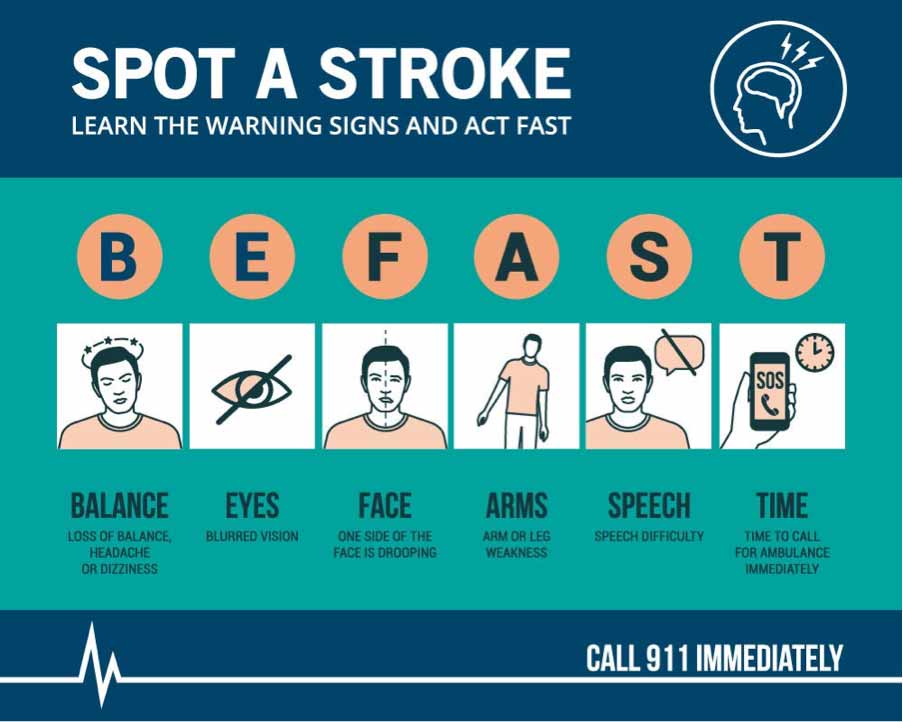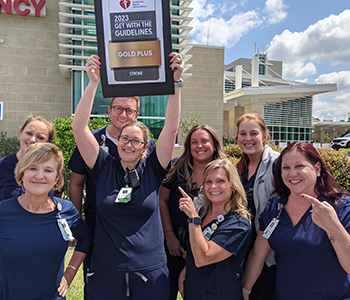
Get SMART About Stroke: Know the Signs. Act Fast. Save a Life.
Emergency? Think You’re Having a Stroke Right Now? Call 911 Immediately.
Do not wait. Every second matters.
Stroke is a medical emergency that requires immediate action. If you or someone around you is showing signs of stroke, the most important thing you can do is call 911. Do not attempt to drive to the hospital or wait for symptoms to pass—early intervention can save a life and prevent serious brain damage.
What is a stroke and why acting fast matters
A stroke occurs when the brain's blood supply is interrupted or reduced, depriving brain tissue of oxygen and nutrients. This can cause brain cells to begin dying within minutes. Prompt medical attention is crucial to minimize damage and improve outcomes.
That’s why at St. Joseph’s/Candler, we’ve built a world-class stroke care program. Our stroke team is available around the clock, combining the expertise of neurologists, emergency physicians, neurosurgeons, radiologists, nurses and paramedics to act quickly when every second counts.

Recognize the signs: B.E. F.A.S.T.
Knowing how to recognize the signs of stroke can mean the difference between life and death, or full recovery and permanent disability. The B.E. F.A.S.T. method is a simple and powerful way to spot stroke symptoms quickly and act without hesitation.
B - Balance loss or dizziness
E - Eyes - blurred or loss of vision
F - Face drooping
A - Arm weakness
S - Speech difficulty
T - Time to call 911 IMMEDIATELY
What to do if you suspect a stroke
If someone is having a stroke, your response in the first few minutes can significantly affect their survival and recovery. Stay calm, act fast, and follow these steps carefully to ensure they receive the best possible care without delay.
- Stay calm and check the time. Stroke treatments are time-sensitive.
- Call 911 immediately. Tell the dispatcher you suspect a stroke.
- Do not drive yourself or the person to the hospital—EMS can begin treatment in the ambulance.
- Note the time symptoms began, or when the person was last seen well.
- Stay with them and keep them safe from falling or further injury.
What happens next: Our rapid stroke response
Once emergency services are called, the stroke response team at St. Joseph’s/Candler is activated. From the moment EMS makes contact, we are prepared to assess, diagnose and treat stroke using advanced tools and protocols to deliver the fastest and most effective care.
Here’s what we offer:
- 24/7 acute stroke assessment team
- Dedicated inpatient stroke unit
- Advanced RAPID software to detect large vessel blockages quickly
- Neurology and neurosurgery backup, available 24/7
- Specialized care pathways for fast decision-making
- Outcome tracking registries to improve care quality
Recognized excellence in stroke care
You deserve care you can trust. St. Joseph’s/Candler has been recognized on both state and national levels for our commitment to stroke care excellence and patient outcomes. These distinctions reflect our high standards, innovative technology and dedicated clinical teams. St Joseph’s/Candler is among the first five U.S. hospitals designated a Primary Stroke Center by The Joint Commission. Both hospitals received Gold Plus awards from the American Heart Association’s Get With the Guidelines – Stroke program, an incredible honor signifying the start of medical excellence to which we adhere in our approach to treating our patients.
 |  |
Know these additional stroke symptoms
While B.E. F.A.S.T. helps recognize the most common symptoms, strokes can be presented in other ways as well. Being aware of these additional signs can help you act even faster and more effectively if something seems off.
Watch for:
- One-sided numbness or paralysis (face, arm, or leg)
- Sudden confusion or trouble speaking
- Difficulty understanding simple statements
- Sudden trouble walking or loss of coordination
- A severe, unexplained headache
- Vision loss in one or both eyes
If you see any of these signs, note the time and call 911 immediately.
How to lower your stroke risk
The good news: many strokes are preventable. Making certain lifestyle and health changes can dramatically lower your risk. By managing chronic conditions and adopting healthier habits, you can protect your brain and your future.
Here are some of the most important ways to reduce your risk of stroke:
- Control high blood pressure
- Treat atrial fibrillation if diagnosed
- Quit smoking
- Limit alcohol intake
- Manage diabetes and cholesterol
- Eat a healthy diet low in salt
- Stay physically active
Community commitment: Education and support
At St. Joseph’s/Candler, we believe that education is a powerful tool in preventing strokes and promoting healing. That’s why we go beyond hospital walls to educate and support our community at every stage of the stroke journey—from prevention to recovery.
Our stroke program also includes:
- A full-time stroke coordinator to support patients and families from admission through discharge
- Post-discharge follow-up calls to track progress and service quality
- Regular community outreach, including stroke screenings and educational events
- Support groups to help stroke survivors and their families navigate life after stroke
We are proud to support the American Stroke Association’s Operation Stroke, promoting awareness and early hospital arrival, and the Georgia Coverdell Stroke Registry, part of a national network improving stroke care.
A stroke doesn't wait—and neither should you. Whether you're seeking care, information or resources for your community, St. Joseph’s/Candler is here to help. Contact us or attend a local stroke education event to stay empowered and prepared.
Stay Informed. Stay Safe. Stay Prepared.
